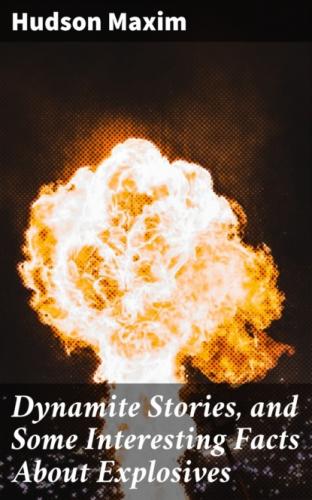THE JOKE WAS NOT ON THE CHINAMEN
THE HAPPENING OF THE UNEXPECTED
THE DOG THAT WAS A REAL MASCOT
DYNAMITE STORIES
INTRODUCTION
SOME INTERESTING FACTS ABOUT EXPLOSIVES
An explosive material consists of a combustible and of an oxidizing agent for burning the combustible. Hence it contains within its own substance the necessary oxygen for its combustion, so that it will burn without atmospheric air and therefore in a confined space.
There are two main kinds of explosive materials—high explosives and gunpowder. There are also two main kinds of high explosives—dynamites and military high explosives. Lastly there are two main kinds of gunpowders—black, smoky gunpowder and smokeless gunpowder.
Dynamite is used mostly for commercial blasting purposes, such as blasting rock in the construction of railways, and so forth. Military high explosives are mostly employed for submarine mines, warheads for torpedoes, and as bursting charges for high explosive projectiles.
A high explosive is consumed almost instantly by what is called a detonative wave; hence it is said to detonate. When gunpowder explodes, it is not consumed by a detonative wave, but burns from the surface, and the more strongly it is confined, that is to say, the higher the pressure under which it is burned, the more rapid is its combustion. Although the action is rapid, it is yet much slower than is the action of detonation of high explosives.
The name gunpowder is a misnomer, for gunpowder is no longer a powder, but is made in the form of hard and dense grains or sticks, according to the use for which it is intended.
A gunpowder is smoky when its products of combustion are not all gaseous. Only about forty-four per cent. of the products of combustion of black gunpowder is gaseous. The rest is inert solid matter, which makes the smoke.
The products of combustion of smokeless powder, however, are practically all gaseous. Consequently, weight for weight, it is much more powerful than black powder.
Black gunpowder is a mechanical mixture of charcoal, sulphur and saltpeter, the charcoal and sulphur being the combustible elements, and the saltpeter the oxidizing element or the element that supplies the oxygen.
In smokeless powder the oxygen is held in chemical union with nitrogen and hydrogen, but the bond between the nitrogen and the other elements is weak, so that when ignited the other more active elements are enabled easily to unite at the expense of the nitrogen.
In the combustion of all explosive materials, great heat is generated, and the force of the explosion is dependent upon the volume of gases and the high temperature to which they are raised.
The smokeless powder used in the United States is made by dissolving a special kind of guncotton or nitrocellulose in ether and alcohol, just sufficient of the solvent being used to gelatinate the nitrocellulose, which is then stuffed through a forming die into rods. The rods are cut into sections of about three diameters long. The die, the invention of the writer, contains seven mandrels arranged in such wise that when the material is forced through the die the bar is multi-perforated with seven holes at equal distances apart. The grains or rods of smokeless powder are then dried for use.
When burned in a cannon, all of the surfaces of the material are practically instantly ignited by a small flash charge of black rifle powder used for the purpose of setting fire to the charge of smokeless powder. The combustion in the perforations causes them to become larger and larger until the grain is all consumed. This form of grain tends better to maintain the pressure behind the projectile in its flight through the gun, and enables the use of larger charges of powder with lower pressures than could otherwise be employed. In fact, it would be impossible to use a smokeless powder made of pure nitrocellulose in big guns without the multi-perforations.
In certain European countries where the multi-perforated powder has not been adopted, nitroglycerin is employed, combined with the nitrocellulose, which causes the material to burn through a greater thickness in a given time. Thus a smokeless powder may be made without the multi-perforations, but smokeless powders containing nitroglycerin erode the guns and destroy them very quickly, while guns employing pure nitrocellulose smokeless powders last much longer.
When one of our big army or navy cannon is fired, the time which elapses from the instant of complete ignition of the powder charge to the instant that the projectile leaves the muzzle of the gun is about the fiftieth or the sixtieth of a second, and in that time the hard and horn-like smokeless powder material is burned through only about a sixteenth of an inch; hence the rate of combustion or rate of explosion of smokeless powder in a cannon is
